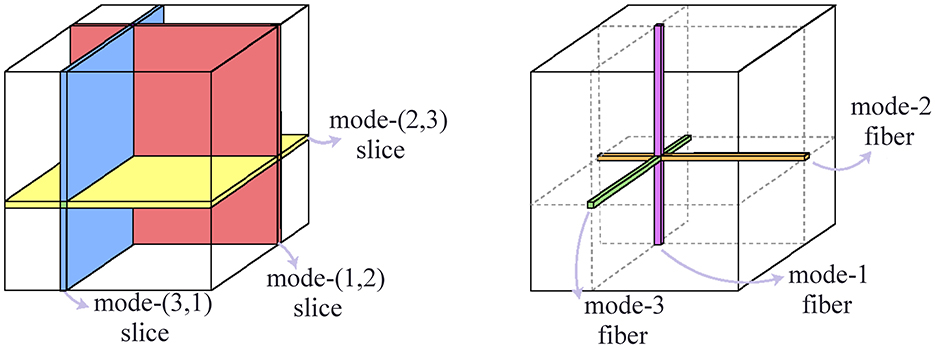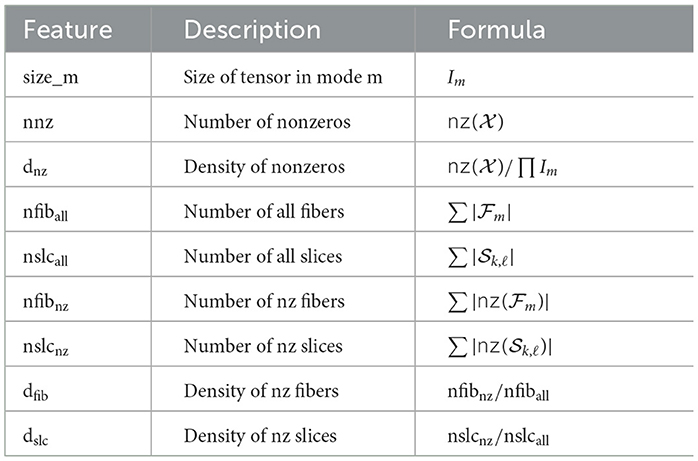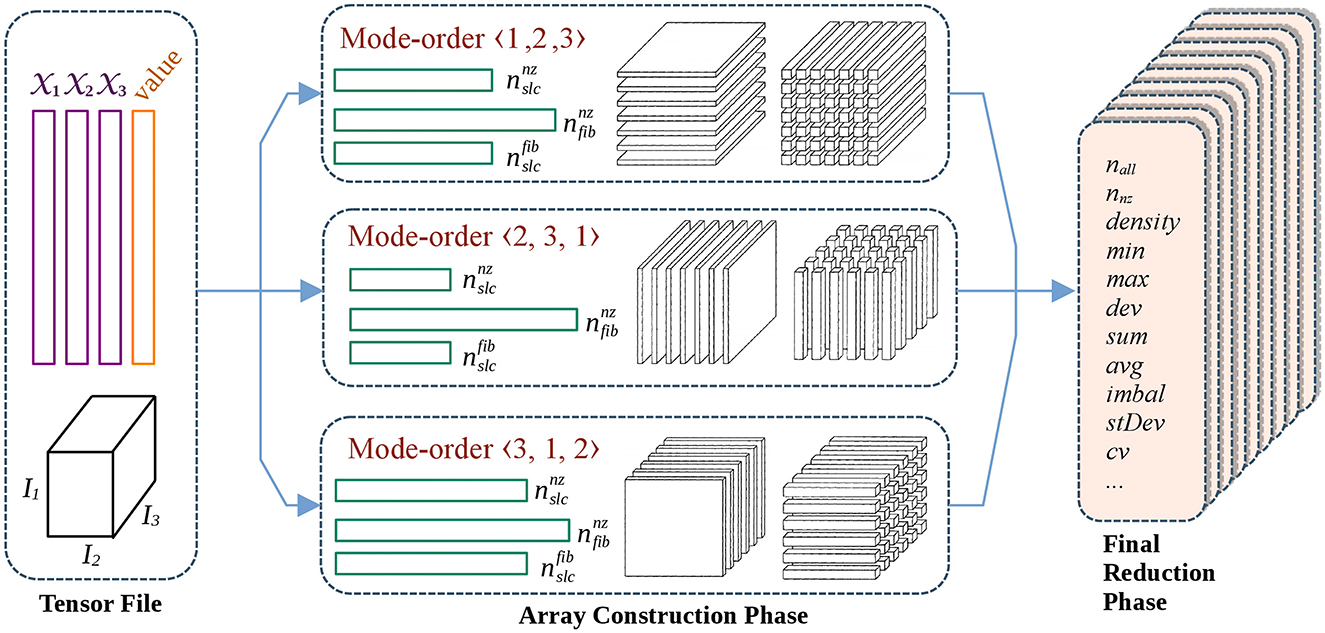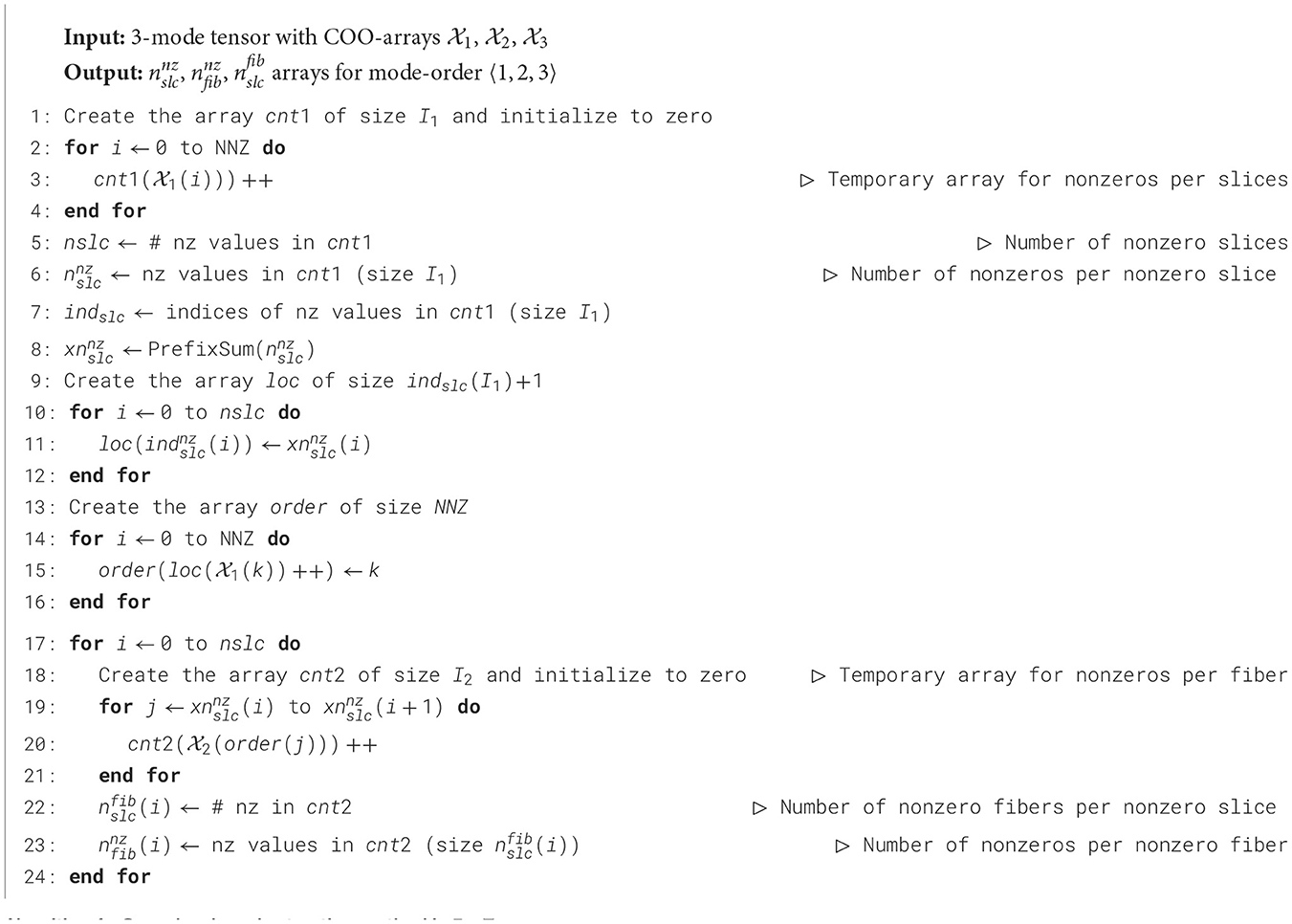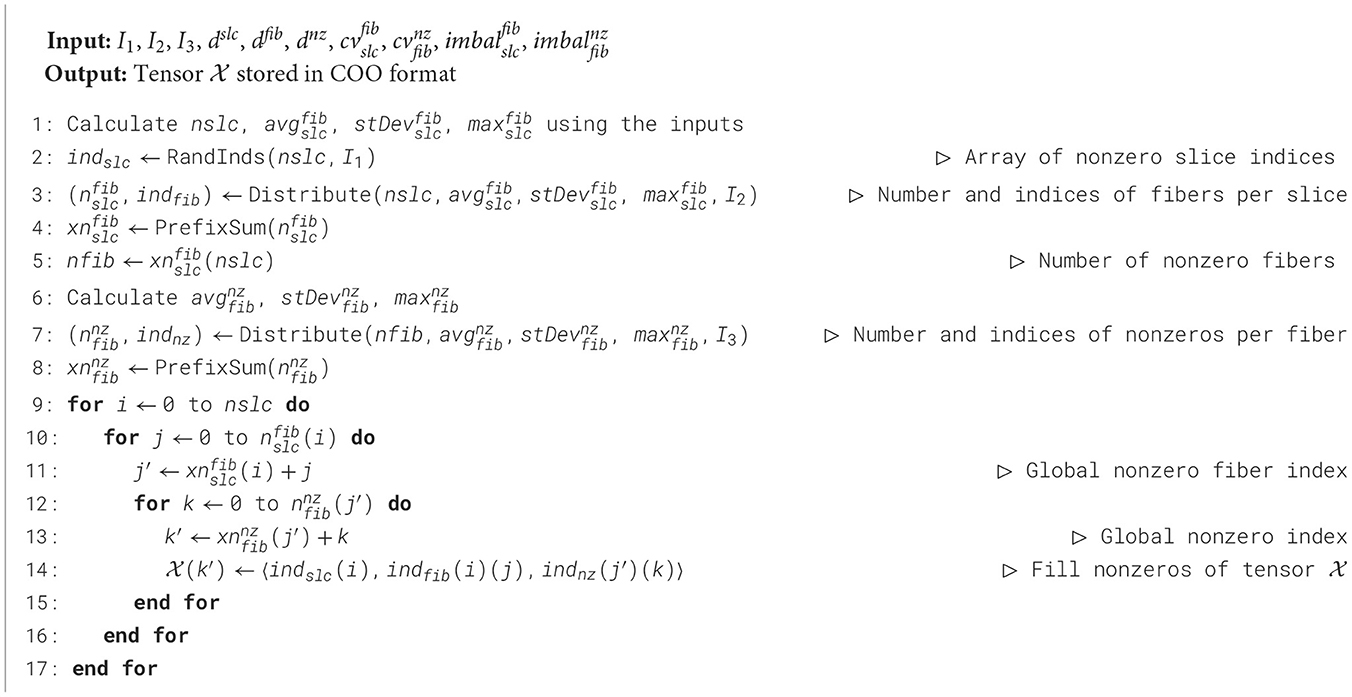- ParCoreLab, Department of Computer Science and Engineering, Koç University, Istanbul, Türkiye
Sparse tensor operations are increasingly important in diverse applications such as social networks, deep learning, diagnosis, crime, and review analysis. However, a major obstacle in sparse tensor research is the lack of large-scale sparse tensor datasets. Another challenge lies in analyzing sparse tensor features, which are essential not only for understanding the nonzero pattern but also for selecting the most suitable storage format, decomposition algorithm, and reordering methods. However, due to the large size of real-world tensors, even extracting these features can be computationally expensive without careful optimization. To address these limitations, we have developed a smart sparse tensor generator that replicates key characteristics of real sparse tensors. Additionally, we propose efficient methods for extracting a comprehensive set of sparse tensor features. The effectiveness of our generator is validated through the quality of extracted features and the performance of decomposition on the generated tensors. Both the sparse tensor feature extractor and the tensor generator are open source with all the artifacts available at https://github.com/sparcityeu/FeaTensor and https://github.com/sparcityeu/GenTensor, respectively.
1 Introduction
Several applications such as social networks, deep learning, diagnosis, crime, and review analysis require the data to be processed in the form of multi-dimensional arrays, namely tensors [1–6]. Tensors are extensions of matrices that can have three or more dimensions, or so-called modes. Tensor decomposition techniques such as Canonical Polyadic decomposition (CPD) and Tucker are widely used to analyze and reveal the latent features of such real-world data in the form of sparse tensors [7, 8]. For making the tensor decomposition methods faster or more memory-efficient, numerous storage formats and partitioning or reordering schemes are introduced in the literature [9–14]. However, the performance of these schemes highly depends on the sparsity pattern of the tensor.
Efficiently extracting the sparsity pattern of a given tensor is essential for optimizing various aspects of tensor analysis and manipulation. The structural features can inform format selection, aiding in determining the most suitable storage format. It can influence the algorithm selection, with different tensor operations exhibiting varying performance based on the sparsity characteristics. Understanding the sparsity pattern also provides insights into the performance of decomposition techniques. In a recent work [15], some tensor features are used to automatically predict the best storage format for a sparse tensor via machine learning techniques. However, the work considers the features for only a single mode, which may cause lack of some critical intuition from other dimensions.
Sparse tensors in real-world scenarios often exhibit extreme sparsity, with densities as low as 10−15. Unlike the sparse matrices often containing at least one nonzero in their rows and columns, sparse tensors contain numerous empty fibers and slices, which are one- and two-dimensional fragments of tensors. A naive approach for extracting sparse tensor features involves traversing the tensor nonzeros in coordinate (COO) format and updating the nonzeros of respective slices and fibers. However, this approach becomes impractical for large tensors with increasing dimensions. Another approach [15] is to assume that the tensor is already sorted to extract the features, yet it reveals the features from only a single mode order. Since the sizes of a sparse tensor diverge a lot along different modes, focusing the features solely on one perspective might lead to the loss of crucial structural information inherent in the tensor.
To tackle these challenges, we develop a sparse tensor feature extraction framework, FEATENSOR, which extracts a detailed and exclusive set of sparse tensor features, encapsulating the features along all modes. It extends the feature set by including important size-independent features such as coefficient of variation and imbalance to gain a deeper insight into the nonzero distribution. Additionally, FEATENSOR offers four alternative feature extraction methods for efficiency, providing flexibility to select the most suitable method based on machine and tensor characteristics.
By utilizing the generated features, machine learning tools can be used to reveal the most suitable storage format, partitioning, or reordering method that fits best with that tensor. Nevertheless, the primary challenge facing this research stems from the necessity of having thousands of samples to train machine learning models. Conversely, the majority of multi-dimensional real-world data require manual cleaning to become readily usable in research. Meanwhile, efforts to gather publicly available real-world data as sparse tensor collections yield only a few instances [16, 17]. Moreover, tensor sizes can be large, making it inconvenient to download, read, and use them in computation. A tensor generator for performance analysis purposes can be handy, enabling the study of algorithms by generating tensors on the fly and discarding them if necessary.
To address these gaps in the literature, we propose a smart sparse tensor generator, GENTENSOR, which accounts for key tensor features during generation. This generator produces sparse tensors with characteristics closely resembling those of real-world tensors, enabling the creation of large-scale sparse tensor datasets. A key advantage of GENTENSOR is its use of size-independent features, such as the coefficient of variation, imbalance, and density, allowing flexible generation of tensors at different scales. This flexibility enables researchers to efficiently prototype and benchmark tensor algorithms on smaller, representative tensors before scaling to real-world datasets. The effectiveness of GENTENSOR is validated by comparing the extracted features and CPD performance of the generated tensors against both naíve random tensors and real-world tensors. These features are obtained using our dedicated feature extraction tool, FEATENSOR, which ensures accurate characterization and comparison of tensor properties.
The main contributions of this work are:
• A sparse tensor feature extraction framework, FEATENSOR, is developed. It includes four different feature extraction methods, which can be used alternatively depending on the computation needs and the characteristics of input tensors. All methods in FEATENSOR are parallelized using OpenMP.
• We develop a smart sparse tensor generator, GENTENSOR, which considers significant tensor features. It can be used to generate an artificial tensor dataset in which the properties and characteristics of the generated tensors are similar to the real-world tensors. GENTENSOR is parallelized with OpenMP for faster generation.
• Experiments on several sparse tensors validate that all feature extraction methods in FEATENSOR give the exact results as feature sets. We present the runtime comparison of the methods in FEATENSOR to guide users to employ the one that is most appropriate to their needs.
• We demonstrate the effectiveness of the proposed tensor generator GENTENSOR in terms of feature quality, tensor decomposition performance, and sensitivity to seed selection.
• Both tools are open source,1,2 accompanied by comprehensive documentation and illustrative examples tailored for the community's usage.
This manuscript is organized as follows. Section 2.1 provides the background information on sparse tensors and tensor decomposition. The proposed feature extraction tool is introduced in Section 2.2. In Section 2.3, we present our sparse tensor generator, GENTENSOR. Experimental results are reported in Section 3. We discuss the related works and limitations in Section 4 and conclude in Section 5.
2 Materials and methods
2.1 Background
A tensor with M dimensions is called an M-mode or Mth order tensor, where the mode count, M, is referred to as the order of tensor. Mode m of a tensor refers to its mth dimension. Fibers are defined as the one-dimensional sections of a tensor obtained by fixing all but one index. Slices are two-dimensional sections of a tensor obtained by fixing every index but two. Figure 1 depicts sample slice and fibers of a 3-mode tensor. The numbers in the naming of slices and fibers derive from the mode indices that are not fixed while forming them. For instance, is a mode-(2,3) slice, and is a mode-3 fiber of a 3-mode tensor , where a tensor element with indices i, j, k is denoted by . A fiber (slice) is said to be a nonzero fiber (slice) if it contains at least one nonzero element; and an empty fiber (slice), otherwise.
To reveal the relationship of data across different modes, tensor decomposition techniques are widely used. Canonical Polyadic Decomposition (CPD) and Tucker decomposition are the two most popular ones among them. In Tucker decomposition, a tensor is decomposed into a much smaller core tensor and a set of matrices; whereas in CPD, a tensor is factorized as a set of rank-1 tensors, which can be considered as a generalization of matrix singular value decomposition (SVD) method for tensors.
There are various implementations for CPD and each has different storage schemes and reordering algorithms proposed specifically for that scheme. SPLATT [18] and ParTI [19] are two commonly-used libraries for CPD. ParTI is a parallel tensor infrastructure that supports essential sparse tensor operations and tensor decompositions on multicore CPU and GPU architectures. SPLATT provides a shared-memory implementation for CPD while adopting a medium-grain partitioning for sparse tensors for parallel execution of CPD.
2.2 Sparse tensor feature extraction
The features of a sparse tensor have the capacity to reveal the most suitable storage format, partitioning or reordering method that fits best with that tensor if well-examined. The main challenge in extracting the sparse tensor features is to determine which and how many fibers and slices are nonzero. This is because the real-world sparse tensors are highly sparse and contain many empty fibers and slices. One naive approach for sparse tensor feature extraction is to traverse the tensor nonzeros in coordinate (COO) format and update the number of nonzeros of the respective slices and fibers. However, this approach is not practical for large tensors since the real-world tensors often have huge numbers of fibers and slices. For instance, some real tensors have more than 1019 fibers, and even storing a boolean array of such a large size requires a space of 10 million Terabytes, which is impractical in modern machines. To overcome these challenges, we propose and implement four alternative methods for sparse tensor feature extraction.
2.2.1 Feature set
We consider three kinds of statistics for sparse tensors: (i) nonzeros per nonzero slices, (ii) nonzeros per nonzero fibers, (iii) nonzero fibers per nonzero slices. Table 1 depicts the global features of the tensor that are independent of these kinds. Table 2 shows the mode- and kind-dependent features that we have extracted for all of these three kinds and for all modes. Here, by referring to all modes, we mean all possible angles that a slice or fiber can have through fixing different modes. For example, mode-(1,2), mode-(2,3), and mode-(3,1) slices represent all modes for slices of a 3-mode tensor. For ease of expression, we refer to the set of slices (fibers) along different modes as slice-modes (fiber-modes).
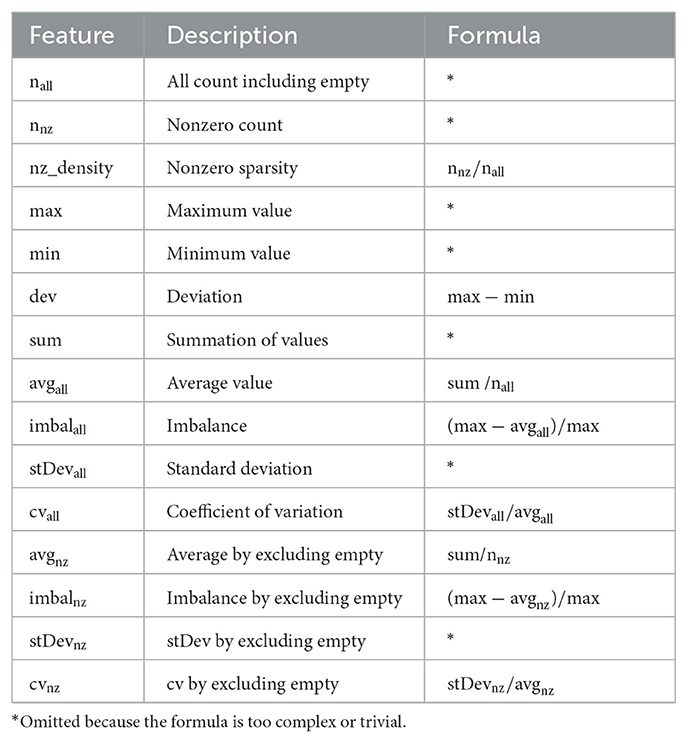
Table 2. Mode- and kind-dependent features that are extracted for each mode and for each kind: (i) nonzeros per slice, (ii) nonzeros per fiber, and (iii) fibers per slice.
A tensor of size I1×I2×⋯ × IM is assumed to be given as an input in Coordinate format, i.e. the extension of matrix-market format for tensors. In the formulas, nz(·) is used as a function returning the number of nonzeros. refers to the set of fibers in mode-m, whereas refers to the set of slices obtained by fixing indices in modes k and ℓ. In the feature names, •nz refers to considering only nonzero kind-entries in the computation, i.e. nonzero fibers or slices, by ignoring the empty fibers or slices. •all refers to considering all kind-entries in the computation, including the empty ones. For instance, for the nonzeros-per-fiber kind in mode 1, nall gives the number of all mode-1 fibers including empty, whereas nnz gives the number of only nonzero fibers along mode-1.
In addition to the tensor features utilized in the related work [15], we also include the features of load imbalance, standard deviation, and coefficient of variation. In Nisa et al. [20], it is shown that a high standard deviation of fiber length causes inter-warp load imbalance and low occupancy; whereas high standard deviation of the slice volume is related to significant inter-thread-block load imbalance. The coefficient of variation is another commonly-used metric for analysis which allows to compare between data sets with widely different means. For example, it is used to evaluate the dispersion of the number of nonzero elements per row for sparse matrix computations [21].
2.2.2 Extraction workflow
The feature extraction process consists of two main stages, namely array construction and the final reduction phases. In the array construction phase, we construct three arrays for all modes: (i) (number of nonzeros per slice), (ii) (number of nonzeros per fiber), (iii) (number of fibers per slice). Here and hereafter, only the nonzero slices and nonzero fibers are considered when referring to slices and fibers, if not stated otherwise. Then in the final reduction phase, we extract all the sparse tensor features by traversing or applying a reduction on these smaller arrays. Both the array construction and the final reduction phases of FEATENSOR are parallelized using OpenMP.
The arrays of and are constructed for each slice-mode, so that there will be of them. The array is constructed for each fiber-mode, hence yielding M different arrays. For instance, for a 3-mode tensor, there are three different types of statistics for and which correspond to mode-(1,2), (2,3), and (3,1) slices; whereas for , there are three different types of statistics corresponding to mode-1, 2, and 3 fibers. Since there are 11 global features and 15 mode- and kind-dependent features, the total number of features extracted for a 3-mode tensor is 15 × 3 × 3 + 11 = 146 in total. For a 4-mode tensor, slices are along different mode pairs, and fibers are along four different modes, so in total 15 × 6 × 2 + 15 × 4 + 11 = 251 features are considered. For 5-mode tensors, slices are along different mode pairs, and fibers are along five different modes, yielding a total of 15 × 10 × 2 + 15 × 5 + 11 = 386 features.
One approach in FEATENSOR is to consider the slice and fiber modes in relation to mode execution orders. By saying mode-order 〈i, j, k〉, we can think that the COO-based index arrays of tensor are virtually rearranged to instead of the original order . In this context, we consider the slices are obtained by fixing all indices except the last two indices, and the fibers are obtained by fixing all indices except the last one. For instance, in mode order 〈1, 2, 3〉, we consider mode-(2,3) slices and mode-3 fibers. The advantage of this approach is to combine slices and fibers so that their corresponding computations may overlap.
Note that especially when computing arrays, two different fiber modes can be associated with each slice mode. To be more specific, to extract the number of fibers per mode-(i, j) slices, it is possible to consider either mode-i or mode-j fibers. For this reason, to cover all slice and fiber modes, one can use both the mode-order set 〈1, 2, 3〉, 〈2, 3, 1〉, 〈3, 1, 2〉 or the mode-order set 〈1, 3, 2〉, 〈2, 1, 3〉, 〈3, 2, 1〉. Figure 2 depicts the workflow of the feature extraction process for a 3-mode sparse tensor for the first case. In the final reduction phase, nine different sets of mode- and kind-dependent features are extracted in parallel, corresponding to three different versions of , , and arrays from distinct mode-orders.
The mode-order approach is especially practical for 3-mode tensors. It is because the number of slice-modes and fiber-modes are both equal to three, making a one-to-one mapping possible between slice- and fiber-modes, hence execution on three distinct mode-orders is sufficient to cover all cases. However, for higher dimensions, it can cause some calculations for to be repeated since the number of slice-modes becomes larger than the number of fiber-modes. Therefore, we obey different approaches in different methods of FEATENSOR.
2.2.3 Extraction methods
In order to overcome the memory and speed limitations in trivial feature extraction approaches, we propose four different feature extraction methods that can be used alternatively depending on the computation needs and the characteristics of input tensors. These methods are heap-based, sorting-based, grouping-based, which is first proposed in this work, and a hybrid method, which is a combination of sorting- and grouping-based methods.
2.2.3.1 Hash-based method
We implement a hash-table-based method to solve the memory issue of the COO-based naive method for large sparse tensors. Instead of long arrays that mostly contain zero values, we use a hash table that has keys as slice or fiber indices and values as the number of nonzeros in the corresponding slice or fiber. Our hashing method excludes ignored dimensions per mode and applies bitwise mixing to ensure a well-distributed hash. The hash table is initialized with 100 buckets, though it dynamically resizes as needed. One main difference of the hash-based method from other methods in FEATENSOR is that it does not follow the mode-order approach in Figure 2, i.e. it does not pair and handle some slice and fibers together, but rather extracts the slice features and fiber features independently.
2.2.3.2 Sorting-based method
Another approach for feature extraction is based on sorting the tensor. It is the conventional approach for extracting the features or constructing compressed storage formats for tensors in the literature [12, 15, 22]. It naturally follows the mode-order approach by sorting the tensor indices according to a given mode-order. After sorting, the array construction phase becomes easier since the nonzeros belonging to the same fiber or slice are positioned consecutively. The related work [15] assumes the tensor to be given as sorted and computes the features only for a single mode-order. However, this assumption is not valid when it comes to executing in the upcoming mode-orders. In other words, a tensor sorted in 〈1, 2, 3〉 order has to be re-sorted for 〈2, 3, 1〉 and 〈3, 1, 2〉 orders to execute the features for other modes. Instead, we find the tensor features along all modes by sorting the related indices of tensor.
2.2.3.3 Grouping-based method
Instead of sorting the tensor nonzeros fully, we group the slices and fibers according to their indices and keep the last indices of the COO format in their original order. We first find the number of nonzero fibers and slices by traversing the tensor entries. We store the indices of these nonzero slices and fibers in a compressed manner and track their nonzero counts in the respective arrays. This algorithm takes inspiration from the construction process of Compressed Sparse Fiber (CSF) format, which is a generalization of Compressed Sparse Row and Compressed Sparse Column (CSR and CSC) formats for higher dimensions.
Algorithm 1 shows the pseudo-code of the grouping-based feature extraction method for the mode-order 〈1, 2, 3〉 of a 3-mode tensor. In this case, the algorithm considers mode-(2,3) slices and mode-3 fibers. cnt1 is a temporary array that keeps the nonzero count information for all slices (Lines 1–4). It is used to obtain the number of nonzero slices (nslc), the array of nonzero counts for each nonzero slice (), the array of indices for nonzero slices (indslc), and the array of starting locations for nonzero slices () that is similar to the row_ptr array in CSR format for matrices (Lines 5–8). loc and order are temporary arrays that are constructed (Lines 10–16) to obtain the cnt2 array, which keeps the nonzero count information for all fibers in each nonzero slice (Lines 18–21). Finally, cnt2 is used to obtain the number of nonzero fibers () and the array of nonzero counts per nonzero fiber () in each nonzero slice (Lines 22–23).
The memory requirement of this algorithm is I1 + I2 + NNZ for executing the (i1, i2, :) fibers of an I1 × I2 × I3 tensor with NNZ nonzeros. The worst case serial runtime is where is the number of nonzero slices in mode 1. For the general case, size(m) × size(m + 1) is a loose upper bound for mode m.
2.2.3.4 Hybrid method
We propose a hybrid method by combining the sorting- and grouping-based methods. The idea is to utilize different methods for extracting features in different modes within the same tensor. This is because the performance of different methods varies depending on the size of the respective mode. Since we observe that sorting- and grouping-based methods are the best-performing ones at the mode level, we use them interchangeably according to the respective mode size. For mode m, we apply the grouping-based method if size(m) × size(m + 1) < λ holds, and we apply the sorting-based method otherwise; where λ is a predetermined threshold. The reasoning behind this choice is to limit the expected worst-case runtime for the respective modes when employing the grouping-based method. We set the threshold λ as 1011 based on empirical evaluations, whose details will be discussed in Section 3.2.
2.2.4 Extension to higher orders
In FEATENSOR, we include two different options for feature extraction of higher-order tensors, namely all-modes and only-3-mode options. The all-modes option extracts all features along all modes. In the only-3-mode option, we extract the features along only the modes with the three largest sizes. That is, tensor modes are sorted according to their sizes, the three largest ones are selected, and the features corresponding solely to those modes are extracted.
As expected, the all-modes option is significantly more time- and resource-intensive. As the tensor order increases, the total number of features across all modes grows dramatically. The large number of features required for extracting higher-order tensors complicates the evaluation process. Instead, the only-3-mode option is sufficient in most cases. For instance, in our tensor generator, GENTENSOR, features for slices and fibers are required only along specific modes. Therefore, the only-3-mode option is adequate for generating tensors with GENTENSOR.
Recall that the mode-order approach used by the sorting-based, grouping-based, and hybrid methods is particularly effective for extracting features along three modes, as the gap between the number of slice modes and fiber modes increases with higher tensor orders. Therefore, we include the all-modes option for higher-order tensors only in the hash-based method, as it does not follow the mode-order approach.
For the only-3-mode option, we extract features along three modes of an M-mode tensor by treating the indices of these three modes as a 3-mode tensor. Therefore, this approach aligns with the mode-order approach. As a result, the only-3-mode option is available for all methods in FEATENSOR.
2.3 Sparse tensor generator
Despite the increased need for research in sparse tensors, publicly available sparse tensor datasets remain limited, comprising only a few instances [16, 17]. To address this scarcity and facilitate the study of machine learning models with a larger variety of sparse tensors, as well as to expand the size of open datasets, we introduce a smart sparse tensor generator, called GENTENSOR. This generator also enables rapid evaluation of proposed methods and algorithms without the necessity of storing the tensor.
2.3.1 Overview
Our generator considers the significant features of tensors. Consequently, the artificial tensors produced by GENTENSOR closely emulate real tensors with their respective features and characteristics. A notable advantage of this developed generator is its utilization of size-independent features, such as coefficient of variation, imbalance, and density. This allows for easy generation of instances with varying sizes, enhancing its versatility and applicability in diverse contexts.
The main idea of the proposed tensor generator is to first determine fiber counts per slice, and the number of nonzeros per fiber according to the given coefficient of variation values. The generator has the flexibility to employ any distribution to determine these counts, yet we are currently utilizing normal or log-normal distributions to determine the nonzero layout. The nonzero numerical values are drawn from a uniform (0,1) distribution, while The positions of the nonzeros and nonzero slice or fiber indices are selected uniformly from the corresponding index ranges.
In GENTENSOR, we provide the option to get the seed for pseudo-randomness from the user. Through this, one can obtain the exact same tensor when providing the same seed in different tests. Moreover, the user can create tensors with almost the same properties by simply changing the seed. The effect of seed selection will be discussed in Section 3.3.3. All levels of GENTENSOR are parallelized using OpenMP for faster execution.
The generator is general and can generate any M-mode tensor. Since generating random sparse tensors while simultaneously adhering to features along all modes is nearly impossible, we opt to consider the features of mode-(M − 1, M) slices and mode-(M − 1) fibers as inputs. For ease of expression, we describe the algorithm for a 3-mode tensor.
2.3.2 The proposed algorithm
The pseudocode of the proposed sparse tensor generator (GENTENSOR) is shown in Algorithm 2. The generator utilizes a set of given metrics to create a tensor having these features: (i) sizes of the tensor I1, I2, I3, (ii) densities of slices, fibers, and nonzeros dslc, dfib, dnz, (iii) coefficient of variations for fibers per slice and nonzeros per fiber , , and (iv) imbalance for fibers per slice and nonzeros per fiber , .
The algorithm first calculates the requested nonzero slice count (nslc), and the average, standard deviation, and maximum values for fibers per slice (, , ) from the given inputs. In line 2, the nonzero slice indices are determined by the RandInds function, which returns nslc many different indices uniformly distributed in the interval [1, I1]. In line 3, the number of fibers per slice () array is constructed and the indices of these nonzero fibers (indfib) are determined respecting the , , and values, using the function Distribute. The details of the Distribute method will be discussed later. A simple prefix sum is applied on and we obtain , to be mainly used in future calculations; yet the number of nonzero fibers (nfib) is derived by using (Lines 4–5).
We calculate the average, standard deviation, and maximum values for nonzeros per fiber (, , ) according to the determined nfib value. In line 7, the number of nonzeros per fiber () array is constructed and the indices of these nonzeros (indnz) are determined respecting the , , values, again using the Distribute method. Similarly, the array is obtained by applying prefix sum on (Line 8). In the last stage of the algorithm (Lines 9–17), the indices of tensor are filled using the arrays indslc, indfib, and indnz.
The pseudocode of the Distribute method is given in Algorithm 3. This method takes five values as inputs, then returns a count array cnt and an index array inds. We utilize the Box-Muller method [23] which generates random numbers with normal distribution obeying a given standard deviation and mean. Since this method obeys a continuous distribution, the values are real and sometimes might be negative. However, our aim here is to construct a count array, e.g. keeping track of the nonzero count in nonzero fibers, so the target values should be positive integers. Thus we round the generated values to the nearest positive integers. To avoid negative values, we switch to the log-normal distribution when needed, which guarantees positive real values.
The algorithm applies normal distribution if most values are expected to be positive (avg − 3 × std > 0), or log-normal distribution, otherwise (Lines 1–8). This choice stems from the fact that ~99.7% of values sampled from a normal distribution fall within three standard deviations of the mean. Then the algorithm scales the values of cnt if the ratio of the resulting over the expected average is outside of a predetermined range, which is determined as (0.95, 1.05) in our case (Lines 10–16). Finally in Lines 17–21, the values of cnt are adjusted to obey the minimum and maximum values, and the indices are selected uniformly using the RandInds method, which returns cnt(i) many indices in the interval [1, limit].
2.3.3 Extension to higher orders
The algorithm of GENTENSOR for higher orders is similar to the one for the 3rd-order case with the main lines. For an M-mode tensor, we consider the features of mode-(M − 1, M) slices and mode-(M − 1) fibers as inputs. The primary additional challenge in a higher-order setting is determining the indices of nonzero slices. It is because for an M-mode tensor, the nonzero slice indices themselves form a (M − 2)-mode smaller boolean tensor, while they were simply scalars for a 3-mode tensor. Therefore, we propose a different scheme to determine the indices of nonzero slices efficiently.
We consider four distinct cases regarding the given slice density, dslc, which is the ratio of nonzero slice count (nslcnz) over the total slice count (nslcall). If dslc > 0.97, we round it to 1.0 and assign the slice indices in sorted order. If dslc ∈ (0.5, 0.97], we create an array of size nslcall to keep track of empty slice indices with the assumption that it can fit into memory, since nslcall can be at most 2 times larger than nslcnz. If dslc ∈ [0.1, 0.5], instead of creating such an array, we traverse all possible nslcall indices and select a fraction of dslc of these indices uniformly. Finally if dslc < 0.1, we simply generate nslcnz many random indices for each of the respective (M − 2) modes.
3 Results
3.1 Experimental setup
The experiments are conducted on an AMD EPYC 7352 CPU of 3200MHz with 512 GB of memory. It has Zen 2 microarchitecture, which includes two sockets, and each socket has 24 cores with two-way simultaneous multi-threading. Both GENTENSOR and FEATENSOR are implemented in C/C++ utilizing OpenMP for shared memory parallelism and compiled with GCC using optimization level O2.
The dataset is taken from two real-world sparse tensor collections, namely FROSTT [17] and HaTen2 [16]. We have excluded the tensors whose nonzero count is more than 1 billion. We have also excluded the delicious-4d tensor since its fiber count exceeds the maximum value (1.8 × 1019) for an unsigned long int in the C language. As a result, the dataset consists of 16 real-world sparse tensors whose properties are given in Table 3. Throughout the section, the runtime results are presented as average of three runs.
3.2 Performance of feature extraction methods
The performance of four different feature extraction methods in FEATENSOR is compared. For this experiment, we use the maximum number of available hardware threads in the machine, which is 96. Since our dataset includes both 3rd-order and higher-order tensors, for a fair comparison, we run all four methods in FEATENSOR with the only-3-mode option, i.e. we extract the features corresponding to modes with the largest three sizes. The time measurement covers extracting all features along all modes, including the preprocessing time for each method, e.g. sorting time for the sort-based method and time for preparing the hash table for the hash-based method. The experiments validate that all feature extraction methods in FEATENSOR give the same and exact results as feature sets, therefore we do not present an accuracy comparison across different methods.
Table 4 presents a detailed runtime comparison between the sort-based and group-based methods at the mode level. The best runtime value for each mode is shown in bold. We also report the value of the decision metric [size(m) × size(m+1)] in the hybrid approach for each mode m. The tensors are shown in increasing order of nonzero counts. It is seen that the superiority of a method varies between different modes within the execution of each tensor. Although the grouping-based method tends to be costly in total time due to some modes with larger sizes, it is still the winner for some modes of even large tensors. This is the main reason why integrating the grouping-based method for specific modes within the hybrid approach yields improved performance. We observe that the grouping method yields the best performance when the corresponding decision metric for that mode is less than 1011 for all cases except LBNL-network, which is the tensor with the smallest nonzero count in our dataset. Therefore, we empirically set the threshold value as λ = 1011 in the hybrid method. This strategy prevents excessive cost in high-dimensional modes and enables faster execution by combining the strengths of both methods.
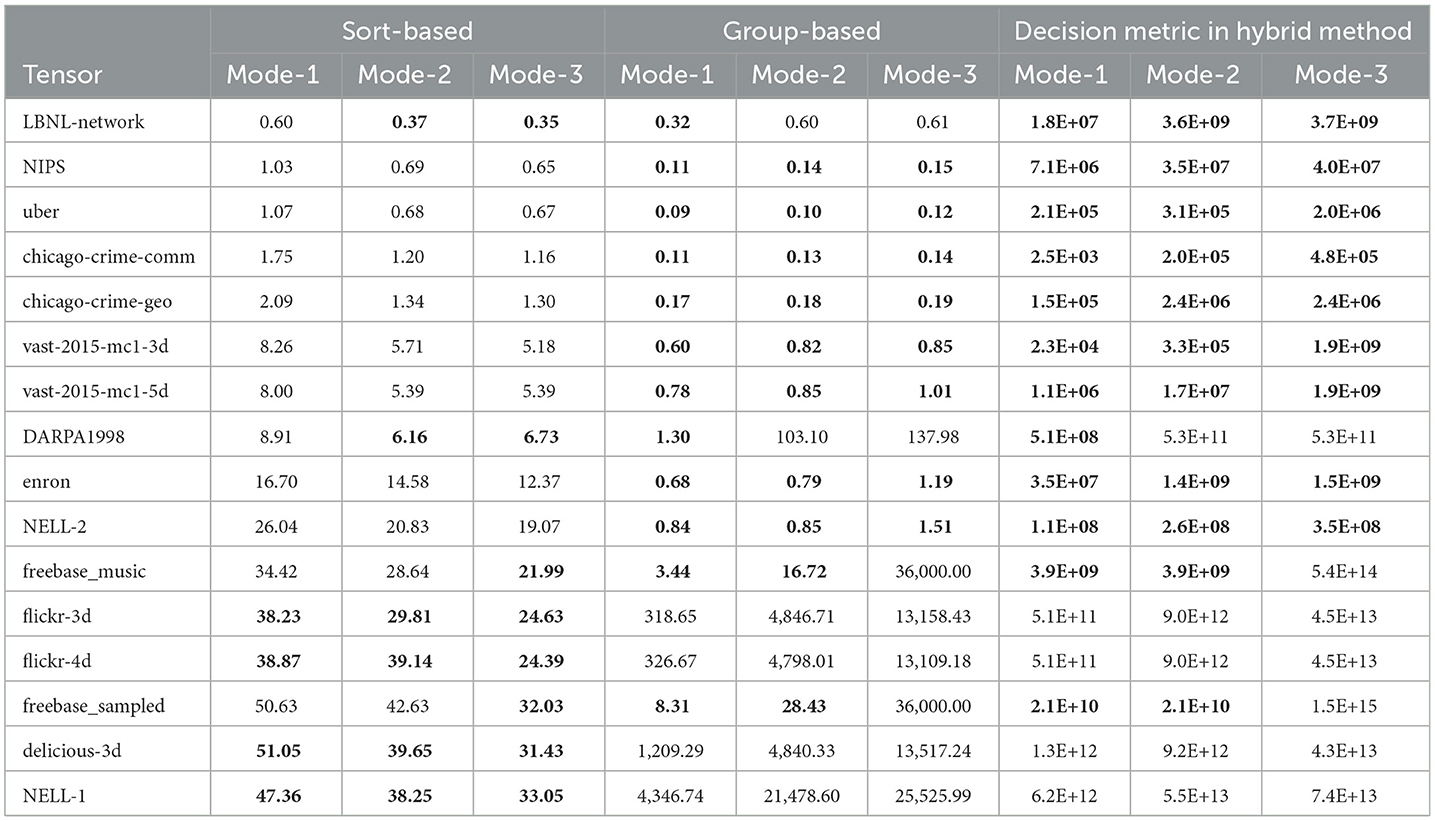
Table 4. Comparison of sort- and group-based methods in terms of mode-level runtime in seconds, where best results for each mode are shown in bold; along with decision metric (size(m) × size(m+1)) values of hybrid method for each mode m, where values < λ = 1011 are shown in bold.
Figure 3 shows the total feature extraction time for each method and each tensor. Excluding the hybrid method, the grouping-based method is superior for smaller tensors, whereas the sort-based method is better for larger tensors. Overall, the hybrid method is the best-performing one for most of the tensors, and it still ranks as the second-best method for the remaining tensors. The results confirm that the hybrid method balances sorting and grouping methods by selecting the appropriate strategy at a mode level according to mode-wise characteristics.
3.3 Performance of tensor generator
We evaluate the effectiveness of the proposed tensor generator in terms of feature quality, tensor decomposition performance, and sensitivity to seed selection. Except for the sensitivity analysis part, we use the generated tensors in which the seed for pseudo-randomness is set to 0. The generated tensors are created by GENTENSOR using the features of real tensors, which are obtained via our feature extractor FEATENSOR. Note that GENTENSOR needs the fiber and slice features from only a single mode, irrespective of the order of the tensor. Since all the methods in FEATENSOR give the same features exactly but only their runtime differ, any of the methods in FEATENSOR can be used to obtain real tensor features as inputs for GENTENSOR.
3.3.1 Feature quality
Table 5 shows the comparison of the generated tensors with their original versions, i.e. real tensors, in terms of some important features. We present the features of the original and the respective generated tensors, as well as the ratio of the resulting value of the generated tensor over that of the original tensor. The ratio values are colored green if the value is between 0.9 and 1.1; red if it is less than 0.5 or more than 2; and orange, otherwise. For zero or too small (less than 0.1) coefficient of variation values, the generator often yields values with zero coefficient of variation. For those cases, the ratio values are omitted from the table since the ratio will appear as either zero or undefined (0/0).
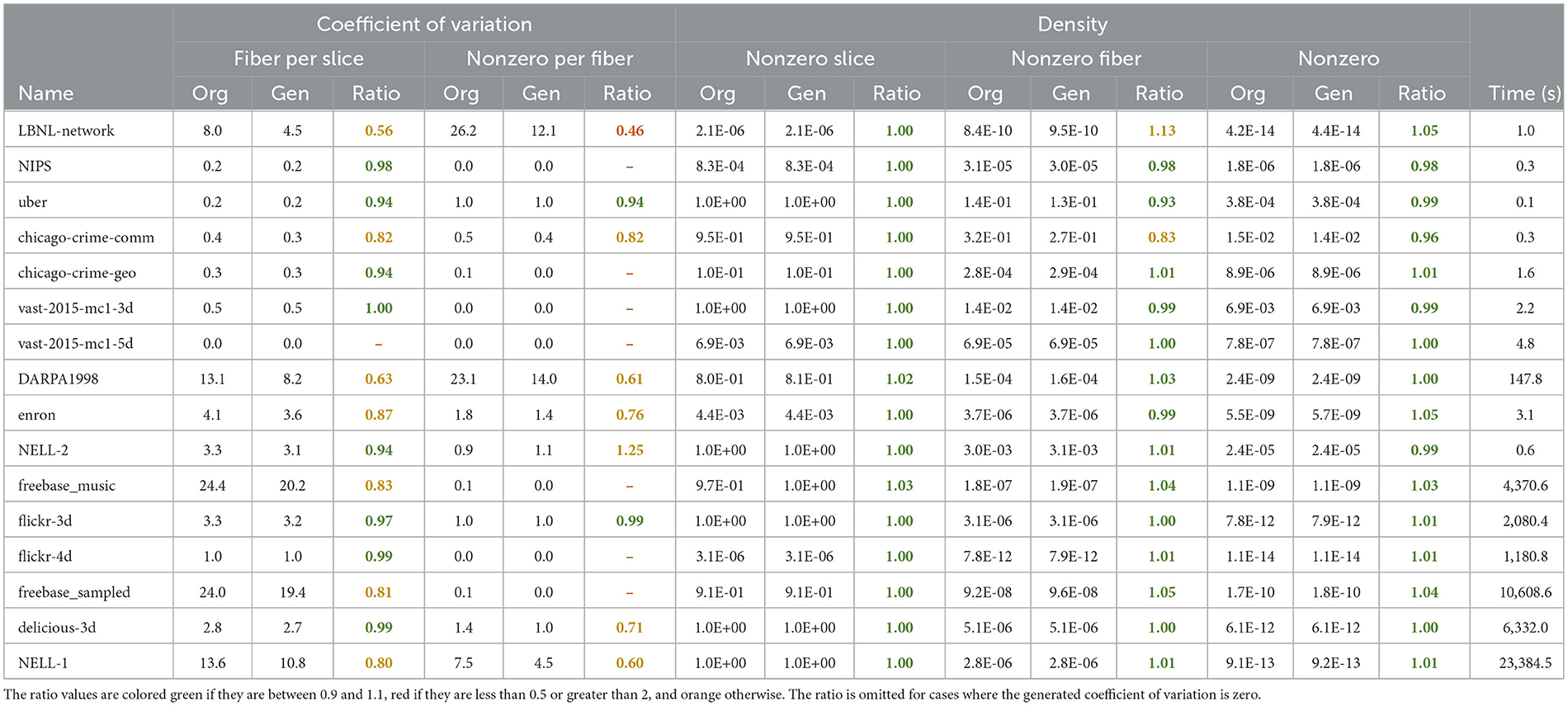
Table 5. Feature comparison of the generated tensors with their original versions, along with the time required to generate each tensor.
As can be seen in the table, the resulting densities, i.e. the nonzero count of the generated tensors, are at least 0.96 times smaller or at most 1.05 times larger than the ones of the respective original tensors. The success of the generator in terms of obeying the given density is seen in both levels of nonzero slice, nonzero fiber, and nonzero density.
In methods that generate values to obey a given density and variation, there is a trade-off between strictly obeying the density or the variation. In other words, if one prioritizes achieving the exact coefficient of variation, the density might get far from the desired value. However, since the number of nonzeros is the most significant feature that a generator must obey for performance concerns, we opted to prioritize adhering to density. For this, in GENTENSOR we apply some scalings during calculations to catch the given density. It is the reason why the resulting ratios in coefficient of variation seem relatively low compared to the ratios in densities.
We also present the tensor generation times in the last column of Table 5. These are the runtimes of GENTENSOR in seconds when working with the maximum available thread count, which is 96 in our case. We observe that GENTENSOR takes only a few seconds when generating medium-size tensors. To be precise, it takes less than 5 seconds for nine out of 16 tensors. Only for some large tensors (four cases in our dataset), the runtime of GENTENSOR can go up to a few hours. Note that the execution of GENTENSOR depends on the requested nonzero count as well as the slice and fiber counts; thus the sizes of the tensor also affect the execution time.
3.3.2 CPD performance
We evaluate the effectiveness of the generated tensors in mimicking the behavior of real tensors, particularly in terms of tensor decomposition performance. For this, the performance of the generated tensors is compared with the performance of the naive random tensors, which have the same sizes and nonzero counts as the original tensors but the nonzero locations are uniformly random. The SPLATT [18] and ParTI [19] tools are used for applying the CPD decomposition. Both tools are constrained to take the same (50) number of iterations for a fair comparison and the time of the first five iterations are ignored for cache warm-up. For each case, we take five independent runs and choose the minimum runtime to represent the peak performance of the system and to be less susceptible to noise than the average.
Figure 4 illustrates the comparison between the generated and naive random tensors in their ability to resemble real tensors regarding the CPD performance. The runtime results for both the naive random and the generated tensors are normalized with respect to the runtime obtained for the respective original tensor. Therefore, the normalized values closer to 1.0 are interpreted as more successful in terms of resembling the original tensor performance.
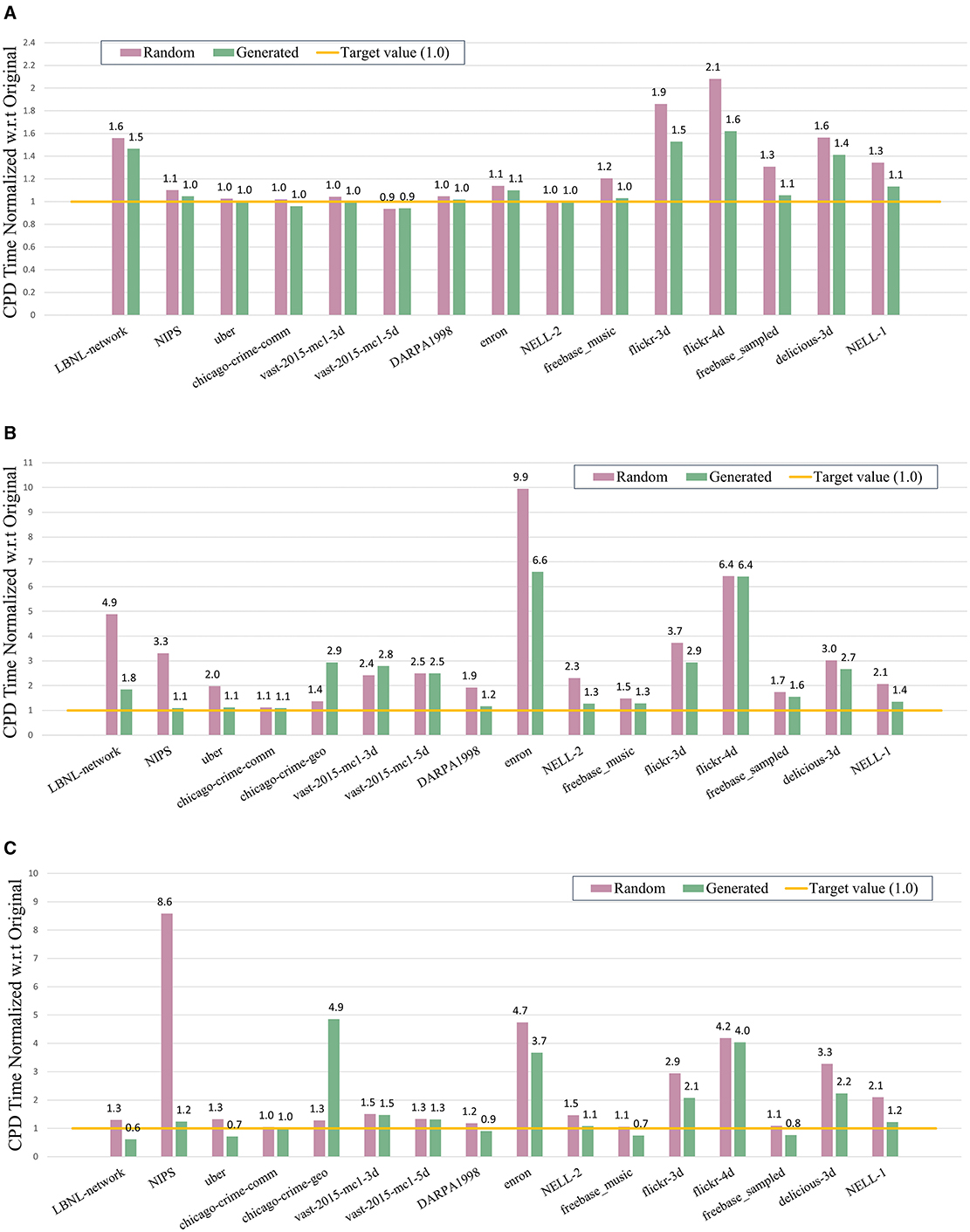
Figure 4. CPD performance comparison of the naive random and the generated tensors. The values are normalized with respect to the runtime obtained for the respective original tensor. (A) ParTI performance comparison for a single thread. (B) SPLATT performance comparison for a single thread. (C) SPLATT performance comparison for 48 threads.
Figure 4A depicts the CPD performance comparison by using the ParTI tool with a single thread. It is evident that the generated tensors emerge as the clear winner in most cases, and in the remaining scenarios, they are comparable to the naive random tensors but never inferior. The superiority of the generated tensors over the naive random ones is especially higher for larger tensors. The ParTI tool gave an error for the chicago-crime-geo tensor, so this tensor is not presented in Figure 4A and the rest of the experiments are conducted by using only the SPLATT tool.
In Figure 4B, we present the CPD performance comparison by using the SPLATT tool with a single thread. As seen in the figure, the generated tensors show significantly better performance than the naive random ones for 11 out of 16 cases; and yield similar performance with naive random tensors for three tensors in the serial setting. For instance, for the NIPS tensor, while the naive random tensor is 3.3 times slower than the original tensor, the tensor generated with GENTENSOR yields a CPD time of only 1.1 times more than the runtime of the original real tensor.
Figure 4C shows the CPD performance comparison by using SPLATT with 48 threads. We observe that the generated tensors are superior to the naive random ones for eight cases; and inferior for only one tensor (chicago-crime-geo). The generated tensors show almost the same performance as the naive random ones for three cases but for those, their performance is either already the same as the respective real tensor (chicago-crime-comm), or only 1.3 (vast-2015-mc1-5d) and 1.5 (vast-2015-mc1-3d) times far from the performance of the original tensors.
Although these results demonstrate that GENTENSOR performs well in most cases, there are a few instances where the generated tensors differ from real tensors in performance. This discrepancy can be attributed to differences in tensor values. Since CPD performance is influenced not only by the sparsity pattern but also by the rank of the tensors, which is an aspect beyond the scope of this work, these value-related differences explain the observed variations. For example, in the case of the chicago-crime-geo tensor, the original nonzeros represent count data and follow a highly skewed distribution. On the other hand, GENTENSOR assigns nonzeros from a uniform (0,1) distribution. Although structurally consistent, this difference in value distribution may result in different numerical scaling and optimization behavior, which explains the deviation in CPD performance observed with SPLATT. This illustrates how even structurally similar tensors may diverge in runtime depending on their value statistics.
3.3.3 Sensitivity analysis
To evaluate the sensitivity of our generator, we produce three different versions for each generated tensor by taking the seed for pseudo-randomness as 0, 1, and 2. Table 6 shows the nonzero counts and the CPD (SPLATT) runtime for 1 and 48 threads (in seconds). We present the coefficient of variation (CV) for each case. As can be seen in the table, the CV for nonzero count is at most 5 × 10−3, whereas the CV for CPD performance is at most 0.1. These results demonstrate that the generator is stable across different random seeds and produces consistent sparsity patterns and decomposition performance. This stability makes GENTENSOR reliable for repeatable experimentation and benchmarking scenarios.
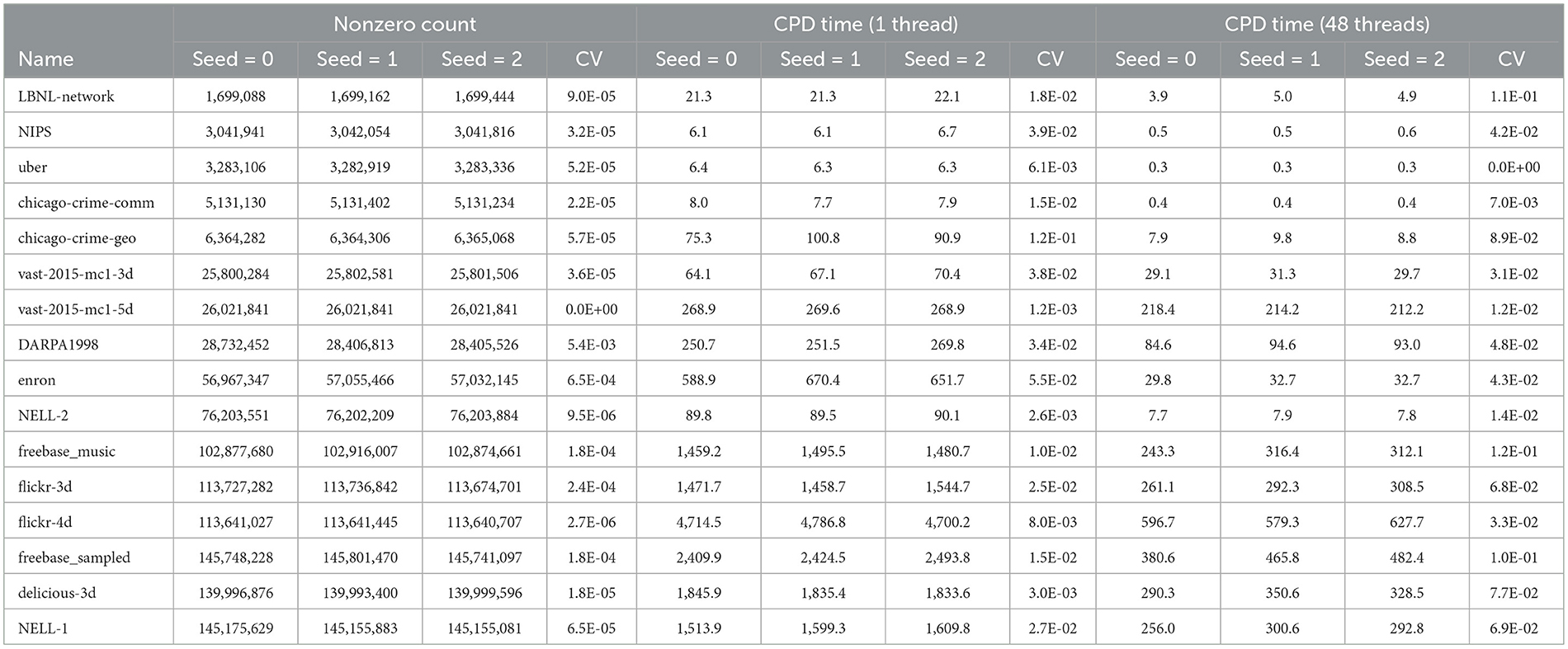
Table 6. Comparison of the generated tensors with different seeds in terms of nonzero count and CPD time in seconds.
3.3.4 Robustness and feature quality in higher orders
To validate the generality of GENTENSOR, we performed a series of experiments on higher-order tensors with the aim of examining how well the generator preserves target structural properties as tensor dimensionality increases. For this purpose, we generated synthetic tensors with orders M = 6, 7, and 8 where all mode sizes are fixed to 1,000. Moreover, to demonstrate the robustness of the generator, we add perturbations in the input structural features (CV and densities) to show they do not drastically change the output structure. Table 7 summarizes the results under six settings, where each row corresponds to a different input configuration.
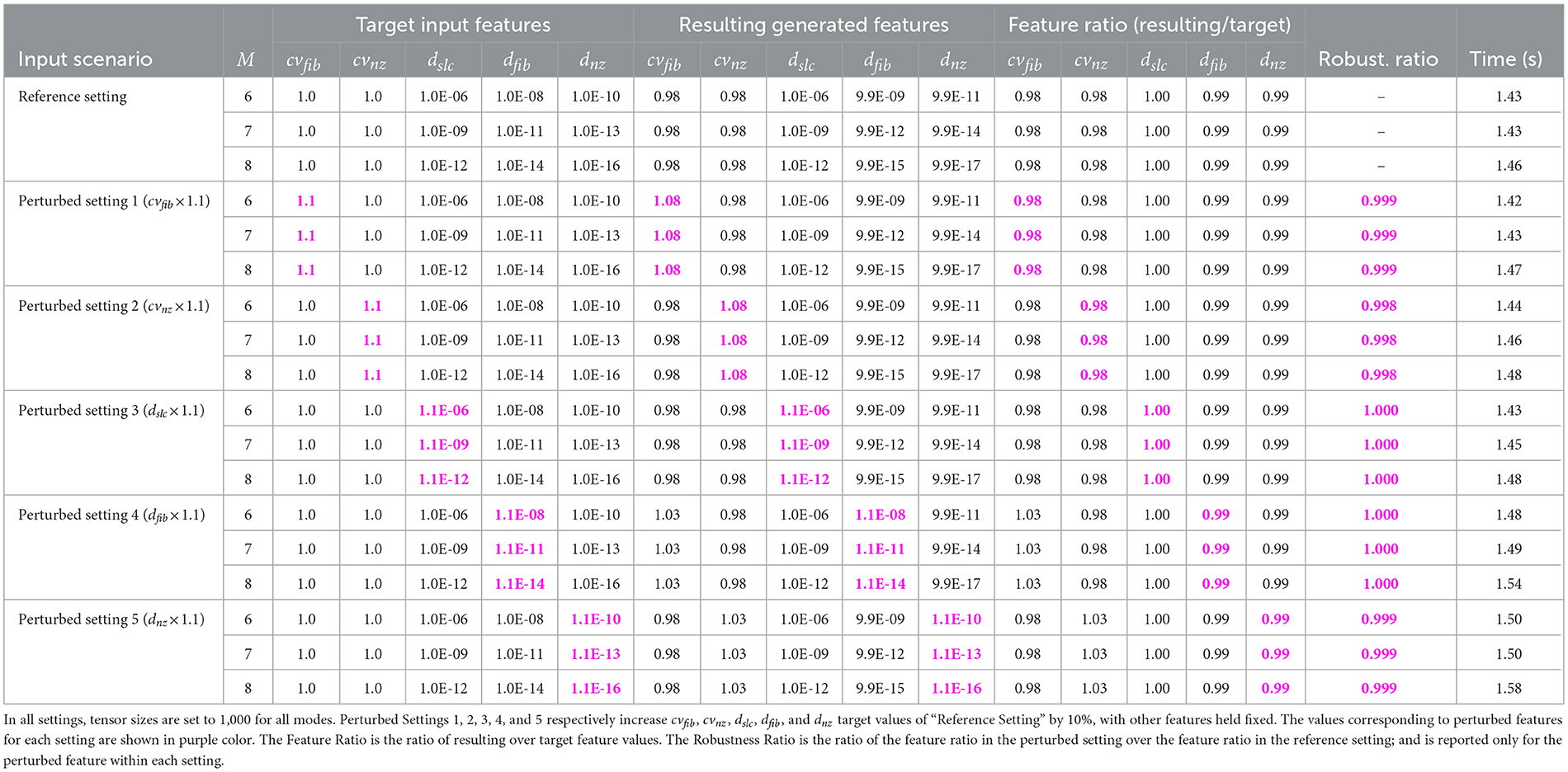
Table 7. Feature matching and structural robustness results, and average generation times for 6th-8th order tensors generated by GENTENSOR under six input settings.
In our Reference Setting, the target CV parameters are set to cvfib = cvnz = 1.0; and the target densities are chosen so that the target setting yields ~1 million nonzero slices, 10 million nonzero fibers, and 100 million nonzeros for all cases with M = 6, 7, and 8. For instance for M = 6, it corresponds to assign cvfib= cvnz=1.0, dslc=10−6, dfib=10−8, and dnz=10−10 as input parameters. In each “Perturbed Setting,” a single input feature of “Reference Setting” is increased by 10%, with other features held fixed: Specifically, Perturbed Settings 1, 2, 3, 4, and 5 respectively increase the target values of cvfib, cvnz, dslc, dfib, and dnz by 10%. For instance for M = 6, Perturbed Setting 1 changes cvfib to 1.1; Perturbed Setting 2 changes cvnz to 1.1; Perturbed Setting 3 updates dslc as 1.1 × 10−6; Perturbed Setting 4 updates dfib as 1.1 × 10−8; and Perturbed Setting 5 only updates dnz as 1.1 × 10−10; while keeping other parameters the same as in the Reference Setting. For each setting, we compare the generated structural features against their target values.
For each setting, we compute the ratio between the resulting value over the target input value; to which we refer as the feature ratio. Results indicate that the generated tensors show close agreement with the specified input features across all orders. For example for the Reference Setting, the resulting CV and density values in the generated tensors deviate by less than 2% and 1% from their targets, respectively. Similarly in perturbed settings, GENTENSOR maintains highly accurate outputs. For all settings and tensor orders, the feature ratios remain between 0.98 and 1.03. These results support that GENTENSOR can effectively reproduce desired structural characteristics even in higher-dimensional settings.
To evaluate robustness, we compare the generator's output in the perturbed setting to its output in the reference setting. We define the robustness ratio as the ratio of the feature ratio in the perturbed setting over the feature ratio in the reference setting. In other words, the robustness ratio measures how proportionally the output feature changes in response to a controlled change in the input feature. A robustness ratio close to 1.0 indicates that the generator reacts proportionally to the input perturbation, which is a desirable robustness property. As shown in Table 7, the robustness ratios range from 0.998 to 1.000 for all perturbed settings and tensor orders. These results demonstrate the structural robustness of GENTENSOR, since it maintains consistent structural behavior under small deviations in input features.
A robustness ratio close to one indicates that the generator reacts proportionally to the input perturbation, which is a desirable robustness property. As shown in Table 7, the robustness ratios across all perturbed features and tensor orders range from 0.998 to 1.000. These results demonstrate that the generator is robust, meaning it maintains consistent structural behavior under small deviations in input features.
The last column of Table 7 reports the tensor generation time as an average of three runs. It is seen that perturbing CV or density does not significantly impact runtime. Furthermore, the runtime shows just a slight and expected increase as M increases, indicating that dimensionality alone does not significantly impact the runtime of GENTENSOR.
4 Discussion
4.1 Related work
To the best of our knowledge, there is only one study (and its extension) that extracts tensor features for optimizing sparse tensor computations in the literature: Sun et al. [24] proposed a framework, namely SpTFS, that automatically predicts the optimal storage format for CPD. SpTFS lowers the sparse tensor to fixed-sized matrices and gives them to convolutional neural networks (CNN) as inputs along with tensor features. The authors improve SpTFS by adopting both supervised and unsupervised learning-based machine learning models in a recent work [15].
The previous works [15, 24] have considered the features for only one mode, assuming that the tensor is already sorted along that mode. However, real-world tensor sizes diverge significantly so that sizes in some modes reach millions while some are only orders of ten or even less. Therefore, considering the global values might result in losing some important information about the structure of the tensor. Moreover, the feature extraction implementation of SpTFS is not publicly available in its official repository [25], which includes only the learning scripts and trained models. In contrast, our FEATENSOR framework provides comprehensive multi-mode feature extraction without requiring any preprocessing. As a publicly available and parallelized tool, FEATENSOR enables broader applicability and reproducibility, making it a more flexible and practical choice for large-scale sparse tensor analysis. Other widely used libraries for tensor decomposition or sparse storage optimization, such as SPLATT [18], ParTI [19], and HiCOO [12], do not provide any documented standalone feature extraction module either. Thus, to the best of our knowledge, FEATENSOR represents the first open-source framework offering parallel, multi-mode feature extraction for sparse tensors.
Although several sparse matrix and graph generators are proposed in the literature [26–30], the studies on sparse tensor generators are very limited. Chi and Kolda [31] aim to produce low rank tensors; and Smith and Karypis [32] used their method to generate synthetic tensors whose values follow a Poisson distribution. Baskaran et al. [33] used MATLAB Tensor Toolkit [34] to generate synthetic sparse tensors but these are rather small tensors with less than one million nonzeros. Due to the deficiency of publicly available sparse tensors, Sun et al. [24] produced synthetic tensors by combining sparse matrices in Suite Sparse [35] collection such that the elements of matrices form the modes of tensors. However real-world tensors are much sparser than real matrices and thus the structure of tensors generated by their method may differ significantly from the real ones.
4.2 Limitations
To the best of our knowledge, FEATENSOR and GENTENSOR are the first open-source tools with feature-preserving tensor generation and efficient multi-method feature extraction for sparse tensors. Despite their demonstrated utility, some limitations remain that offer opportunities for future enhancement. While this work primarily focuses on replicating structural sparsity patterns, it does not explicitly incorporate constraints on nonzero values or tensor rank. These aspects may affect downstream tasks such as classification, regression, or clustering, where the semantics of nonzero entries are important.
Additionally, although both FEATENSOR and GENTENSOR are parallelized via OpenMP for shared-memory systems, their applicability to distributed-memory environments remains unexplored. Extending these tools to scale across nodes would broaden their utility in HPC settings. Addressing these aspects would further enhance the quality of these tools, making it a promising direction for future research.
GENTENSOR is designed with the flexibility to incorporate any distribution. However, its current version utilizes normal and log-normal distributions to determine the nonzero layout. Furthermore, the positions of the nonzeros, as well as the indices of nonzero slices and fibers, are selected uniformly, and nonzero values are drawn from a uniform distribution. As part of future work, we plan to extend GENTENSOR by exploring alternative distribution models for both layout and value generation.
In this work, the effectiveness of GENTENSOR has mainly been demonstrated through matching structural features and replicating CPD performance. These evaluation metrics were selected to capture both the structural fidelity and practical applicability of the generated tensors. Nonetheless, we acknowledge that other potential indicators could offer complementary perspectives. For instance, tensor rank or spectral characteristics might provide insight into latent structure fidelity. Moreover, evaluating the generated tensors under alternative decomposition models, such as Tucker, could reveal behavioral differences not captured by CPD alone. Graph-based similarity metrics also present a potential direction. While such alternatives may broaden the scope of evaluation, they often depend on specific applications or assumptions, which our current generic generator intentionally avoids. Exploring these dimensions in a targeted context remains a promising direction for future work.
5 Conclusion
In this study, we introduce two tools, FEATENSOR and GENTENSOR, which we designed and developed to advance research in sparse tensor operations. FEATENSOR is a feature extraction framework for sparse tensors that provides four different methods, prioritizing efficiency in extracting tensor features. It serves as the first publicly available, multi-mode, and parallel feature extraction framework for sparse tensors. This contribution is particularly valuable, as feature extraction itself is challenging and computationally expensive due to the large number of fibers and slices in real sparse tensors. We evaluate the performance of various feature extraction methods and observe that the methods introduced in this work outperform conventional approaches.
GENTENSOR is a smart sparse tensor generator that adheres to a comprehensive set of tensor features. Experimental results validate its effectiveness in mimicking real tensors, both in terms of sparsity patterns and tensor decomposition performance. A key advantage of GENTENSOR is its use of size-independent features, enabling the generation of tensors at different scales while preserving essential properties of real tensors. This capability facilitates the creation of large synthetic sparse tensor datasets that exhibit characteristics and behavior similar to real-world data. This is particularly useful for performance and scaling experiments involving tensor decomposition kernels that depend on tensor sparsity patterns. Moreover, experimental results demonstrate that GENTENSOR generalizes well to higher-order tensors and is robust to typical variations in the input feature set. The generator can therefore be reliably used in realistic benchmarking and modeling scenarios where input characteristics may not be precisely known.
Data availability statement
Publicly available datasets were analyzed in this study. This data can be found at: http://frostt.io/tensors/; https://datalab.snu.ac.kr/haten2/.
Author contributions
TT: Conceptualization, Data curation, Formal analysis, Investigation, Methodology, Software, Supervision, Visualization, Writing – original draft, Writing – review & editing. AT: Software, Writing – original draft, Writing – review & editing. DU: Writing – original draft, Funding acquisition, Project administration, Supervision, Writing – review & editing.
Funding
The author(s) declare that financial support was received for the research and/or publication of this article. This work was supported by the European Research Council (ERC) under the European Union's Horizon 2020 research and innovation programme (grant agreement no. 949587) and EuroHPC Joint Undertaking through the grant agreement no. 956213.
Acknowledgments
We thank Eren Yenigul from Koç University for his contributions in developing the FEATENSOR tool.
Conflict of interest
The authors declare that the research was conducted in the absence of any commercial or financial relationships that could be construed as a potential conflict of interest.
Generative AI statement
The author(s) declare that no Gen AI was used in the creation of this manuscript.
Publisher's note
All claims expressed in this article are solely those of the authors and do not necessarily represent those of their affiliated organizations, or those of the publisher, the editors and the reviewers. Any product that may be evaluated in this article, or claim that may be made by its manufacturer, is not guaranteed or endorsed by the publisher.
Footnotes
References
1. Kuang L, Hao F, Yang LT, Lin M, Luo C, Min G. A tensor-based approach for big data representation and dimensionality reduction. IEEE Trans Emerg Top Comput. (2014) 2:280–91. doi: 10.1109/TETC.2014.2330516
2. Leclercq É, Savonnet M. A tensor based data model for polystore: an application to social networks data. In: Proceedings of the 22nd International Database Engineering & Applications Symposium. (2018). p. 110–8. doi: 10.1145/3216122.3216152
3. Acar E, Aykut-Bingol C, Bingol H, Bro R, Yener B. Multiway analysis of epilepsy tensors. Bioinformatics. (2007) 23:i10–8. doi: 10.1093/bioinformatics/btm210
4. Mu Y, Ding W, Morabito M, Tao D. Empirical discriminative tensor analysis for crime forecasting. In: Knowledge Science, Engineering and Management: 5th International Conference, KSEM 2011, Irvine, CA, USA, December 12-14, 2011. Proceedings 5. Cham: Springer (2011). p. 293–304. doi: 10.1007/978-3-642-25975-3_26
5. Jukić A, Kopriva I, Cichocki A. Noninvasive diagnosis of melanoma with tensor decomposition-based feature extraction from clinical color image. Biomed Signal Process Control. (2013) 8:755–63. doi: 10.1016/j.bspc.2013.07.001
6. Yelundur AR, Chaoji V, Mishra B. Detection of review abuse via semi-supervised binary multi-target tensor decomposition. In: Proceedings of the 25th ACM SIGKDD International Conference on Knowledge Discovery & Data Mining. New York, NY: ACM (2019). p. 2134–44. doi: 10.1145/3292500.3330678
7. Kolda TG, Bader BW. Tensor decompositions and applications. SIAM Eev. (2009) 51:455–500. doi: 10.1137/07070111X
8. Goulart JHdM, Boizard M, Boyer R, Favier G, Comon P. Tensor CP decomposition with structured factor matrices: algorithms and performance. IEEE J Sel Top Signal Process. (2015) 10:757–69. doi: 10.1109/JSTSP.2015.2509907
9. Li J, Uçar B, Çatalyúrek ÚV, Sun J, Barker K, Vuduc R. Efficient and effective sparse tensor reordering. In: Proceedings of the ACM International Conference on Supercomputing. New York, NY: ACM (2019). p. 227–37. doi: 10.1145/3330345.3330366
10. Acer S, Torun T, Aykanat C. Improving medium-grain partitioning for scalable sparse tensor decomposition. IEEE Trans Parallel Distrib Syst. (2018) 29:2814–25. doi: 10.1109/TPDS.2018.2841843
11. Kaya O, Uçar B. Parallel candecomp/parafac decomposition of sparse tensors using dimension trees. SIAM J Sci Comput. (2018) 40:C99–130. doi: 10.1137/16M1102744
12. Li J, Sun J, Vuduc R. HiCOO: hierarchical storage of sparse tensors. In: SC18: International Conference for High Performance Computing, Networking, Storage and Analysis. Dallas, TX: IEEE (2018). p. 238–52. doi: 10.1109/SC.2018.00022
13. Shivakumar S, Li J, Kannan R, Aluru S. Efficient parallel sparse symmetric Tucker decomposition for high-order tensors. In: SIAM Conference on Applied and Computational Discrete Algorithms (ACDA21). Dallas, TX: SIAM (2021). p. 193–204. doi: 10.1137/1.9781611976830.18
14. Helal AE, Laukemann J, Checconi F, Tithi JJ, Ranadive T, Petrini F, et al. ALTO: adaptive linearized storage of sparse tensors. In: Proceedings of the ACM International Conference on Supercomputing. New York, NY: ACM (2021). p. 404–16. doi: 10.1145/3447818.3461703
15. Sun Q, Liu Y, Yang H, Dun M, Luan Z, Gan L, et al. Input-aware sparse tensor storage format selection for optimizing MTTKRP. IEEE Trans Comput. (2021) 71:1968–81. doi: 10.1109/TC.2021.3113028
16. Jeon I, Papalexakis EE, Kang U, Faloutsos C. HaTen2: billion-scale tensor decompositions. In: 2015 IEEE 31st International Conference on Data Engineering. Seoul: IEEE (2015). p. 1047–58. doi: 10.1109/ICDE.2015.7113355
17. Smith S, Choi JW, Li J, Vuduc R, Park J, Liu X, et al. FROSTT: The Formidable Repository of Open Sparse Tensors and Tools. (2017). Available online at: http://frostt.io/ (Accessed June 10, 2025).
18. Smith S, Ravindran N, Sidiropoulos ND, Karypis G. SPLATT: efficient and parallel sparse tensor-matrix multiplication. In: 2015 IEEE International Parallel and Distributed Processing Symposium. Hyderabad: IEEE (2015). p. 61–70. doi: 10.1109/IPDPS.2015.27
19. Li J, Ma Y, Yan C, Sun J, Vuduc R. ParTI!: a parallel tensor infrastructure for data analysis. In: NIPS, Tensor-Learn Workshop. Barcelona (2016).
20. Nisa I, Li J, Sukumaran-Rajam A, Vuduc R, Sadayappan P. Load-balanced sparse MTTKRP on GPUs. In: 2019 IEEE International Parallel and Distributed Processing Symposium (IPDPS). Rio de Janeiro: IEEE (2019). p. 123–33. doi: 10.1109/IPDPS.2019.00023
21. Abu-Sufah W, Abdel Karim A. Auto-tuning of sparse matrix-vector multiplication on graphics processors. In: International Supercomputing Conference. Cham: Springer (2013). p. 151–64. doi: 10.1007/978-3-642-38750-0_12
22. Smith S, Karypis G. Tensor-matrix products with a compressed sparse tensor. In: Proceedings of the 5th Workshop on Irregular Applications: Architectures and Algorithms. New York, NY: IEEE (2015). 1–7. doi: 10.1145/2833179.2833183
23. Golder E, Settle J. The Box-Múller method for generating pseudo-random normal deviates. J R Stat Soc Ser C. (1976) 25:12–20. doi: 10.2307/2346513
24. Sun Q, Liu Y, Dun M, Yang H, Luan Z, Gan L, et al. SpTFS: Sparse tensor format selection for MTTKRP via Deep learning. In: SC20: International Conference for High Performance Computing, Networking, Storage and Analysis. Atlanta, GA: IEEE (2020). p. 1–14. doi: 10.1109/SC41405.2020.00022
25. Sun Q, Liu Y, Dun M, Yang H, Luan Z, Gan L, et al. SpTFS: Sparse Tensor Format Selection. (2020). Available online at: https://github.com/sunqingxiao/SpTFS (Accessed June 10, 2025).
26. Luszczek P, Tsai Y, Lindquist N, Anzt H, Dongarra J. Scalable data generation for evaluating mixed-precision solvers. In: 2020 IEEE High Performance Extreme Computing Conference (HPEC). Waltham, MA: IEEE (2020). p. 1–6. doi: 10.1109/HPEC43674.2020.9286145
27. Mpakos P, Galanopoulos D, Anastasiadis P, Papadopoulou N, Koziris N, Goumas G. Feature-based SPMV performance analysis on contemporary devices. In: 2023 IEEE International Parallel and Distributed Processing Symposium (IPDPS). St. Petersburg, FL: IEEE (2023). p. 668–79. doi: 10.1109/IPDPS54959.2023.00072
28. Kolda TG, Pinar A, Plantenga T, Seshadhri C. A scalable generative graph model with community structure. SIAM J Sci Comput. (2014) 36:C424–52. doi: 10.1137/130914218
29. Armstrong W, Rendell AP. Reinforcement learning for automated performance tuning: Initial evaluation for sparse matrix format selection. In: 2008 IEEE International Conference on Cluster Computing. Tsukuba: IEEE (2008). p. 411–20. doi: 10.1109/CLUSTR.2008.4663802
30. Bonifati A, Holubová I, Prat-Pérez A, Sakr S. Graph generators: state of the art and open challenges. ACM Comput Surv. (2020) 53:1–30. doi: 10.1145/3379445
31. Chi EC, Kolda TG. On tensors, sparsity, and nonnegative factorizations. SIAM J Matrix Anal Appl. (2012) 33:1272–99. doi: 10.1137/110859063
32. Smith S, Karypis G. Accelerating the tucker decomposition with compressed sparse tensors. In: European Conference on Parallel Processing. Cham: Springer (2017). p. 653–68. doi: 10.1007/978-3-319-64203-1_47
33. Baskaran M, Meister B, Vasilache N, Lethin R. Efficient and scalable computations with sparse tensors. In: 2012 IEEE Conference on High Performance Extreme Computing. Waltham, MA: IEEE (2012). p. 1–6. doi: 10.1109/HPEC.2012.6408676
34. Kolda TG, Bader BW. MATLAB Tensor Toolbox. Albuquerque, NM: Sandia National Laboratories (SNL) (2006).
Keywords: sparse tensor, tensor generators, feature extraction, synthetic data generation, shared memory parallelism
Citation: Torun T, Taweel A and Unat D (2025) A sparse tensor generator with efficient feature extraction. Front. Appl. Math. Stat. 11:1589033. doi: 10.3389/fams.2025.1589033
Received: 06 March 2025; Accepted: 30 June 2025;
Published: 30 July 2025.
Edited by:
Gaohang Yu, Hangzhou Dianzi University, ChinaReviewed by:
Qingxiao Sun, China University of Petroleum, Beijing, ChinaZiyan Luo, Beijing Jiaotong University, China
Copyright © 2025 Torun, Taweel and Unat. This is an open-access article distributed under the terms of the Creative Commons Attribution License (CC BY). The use, distribution or reproduction in other forums is permitted, provided the original author(s) and the copyright owner(s) are credited and that the original publication in this journal is cited, in accordance with accepted academic practice. No use, distribution or reproduction is permitted which does not comply with these terms.
*Correspondence: Didem Unat, ZHVuYXRAa3UuZWR1LnRy
 Tugba Torun
Tugba Torun Ameer Taweel
Ameer Taweel Didem Unat*
Didem Unat*